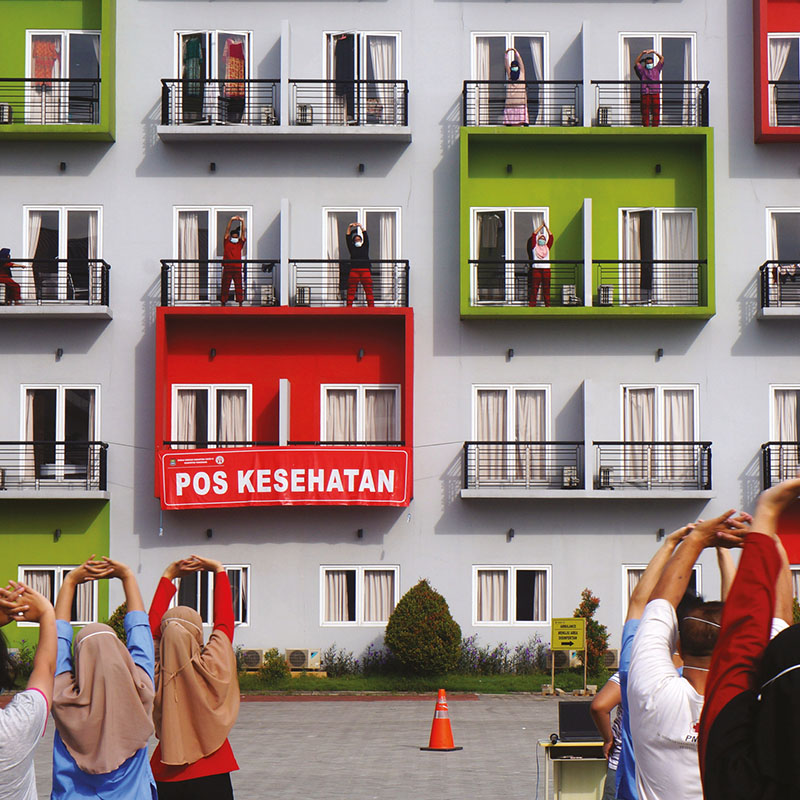Density versus COVID-19: An Indonesian Case Study
September 24, 2020
Diseases and plagues, their spread and the stories thereof are as old as mankind and are extensively documented in well-known ancient texts. As long as people gather, mingle and travel to different places, they spread diseases. Medieval European cities were death traps partly due to a lack of hygiene and sanitation.
More people died during then in cities than were born, thus cities had to rely heavily on migration from rural areas [1]. Gradually with the increase and advancement of medical knowledge, cities started to change. Access to fresh air and daylight, through master planning, zoning laws and parks, as well as fresh water supply, sewage systems and waste management in the form of public services, were built and put into place.
These efforts and transformations happened in different cities and countries from the mid-19th century onwards, like Haussmann’s reworking of Paris or London’s Metropolitan Board of Works to manage growth and densities, and keep the population healthy. In that sense, past epidemics have shaped cities and generated new building regulations. Yet, the great tragedies of the 20th century in our collective minds are often World War I and II, and not the Spanish flu.

Pati, Indonesia, 24 May 2020: Aerial shot of devotees at prayer at a mosque with social distancing (bagussatria/Shutterstock.com)
DENSITY: HIGH AND LOW
Despite higher infection risks, high density is still what that makes a city. Managing the COVID-19 crisis seems to circle around the ability to manage densities and behaviour of people occupying a certain area simultaneously.
But what is density? Density means the number of people per land area, which is represented by the number of buildings per area. Manhattan’s density is considered high, at 27,544 persons per square kilometre, while the densest area is Dharavi in Mumbai, at 277,136 persons per square kilometre.

Tangerang, Indonesia, 28 May 2020: Volunteers guide COVID-19 patients to exercise in the morning (Fajrin Raharjo/Shutterstock.com)
In contrast, Los Angeles’s density is low at 2,913 persons per square kilometre, characterised by a consistent sprawl of low rises, excluding its financial district. Jakarta’s city density is at 14,464 persons per square kilometre, while its metropolitan density is at 4,958 persons per square kilometre. These numbers are average densities, which do not necessarily mean a sense of crowdedness along the streets. There are places in Jakarta where Los Angeles and Dharavi’s densities coexist side by side.
High density does not necessarily mean a more negative outcome in managing COVID-19, as can be seen in the special cases of Taiwan or South Korea. High density can also mean a higher concentration of medical help, expertise and equipment paired with shorter travel routes and faster response times, as compared to rural areas for example.
The question here is: when does density become a deadly threat and when is it manageable? How dense is too dense and generally how prepared is a government or municipality to manage these densities and their citizens? Cultural aspects also play a role: how disciplined is a society and how likely are they to follow rules?
References
[1] Manuel De Landa. 2000. A Thousand Years of Nonlinear History. New York: Zone Books.
[2] Media, Kompas Cyber. 2020. “MUI, NU, Dan Muhammadiyah Imbau Pelaksanaan Shalat Idul Fitri Di Rumah, Berikut Tata Caranya…” KOMPAS.Com. May 23, 2020. https://www.kompas.com/ramadhan/read/2020/05/23/175700872/mui-nu-danmuhammadiyah-imbau-pelaksanaan-shalat-idul-fitri-di-rumah. Accessed on 10 June 2020.
3 Kompas.id. 2020. “Covid-19 Meningkat Di Pusat Kota.” Kompas.Id. May 18, 2020. https://kompas.id/baca/metro/2020/05/18/covid-19-meningkat-di-pusat-kota/. Accessed on 1 June 2020.
4 Suara.com. 2020. “Cegah Corona, Tri Rismaharini Tambah Armada Transportasi Umum.” Suara.Com. March 18, 2020. https://www.suara.com/news/2020/03/18/113749/cegah-corona-tri-rismaharini-tambah-armada-transportasi-umum. Accessed on 1 June 2020.
5 Pemprov DKI Jakarta. 2020b. “16 Maret 2020 Gub Anies Baswedan Memimpin Rapat Teknis Terkait Percepatan Penanganan COVID-19.” https://www.youtube.com/watch?v=HV_onj7Y4nY&feature=youtu.be. Accessed on 7 June 2020.
6 Media, Kompas Cyber. 2020a. “Dibanderol Rp 70.000, Surat Keterangan Bebas Covid-19 Sempat Dijual Di Tokopedia.” KOMPAS.Com. May 14, 2020. https://megapolitan.kompas.com/read/2020/05/14/17195391/dibanderol-rp-70000-surat-keterangan-bebas-covid-19-sempat-dijual-di. Accessed on 16 June 2020.
To read the complete article, get your hardcopy at our online shop/newsstands/major bookstores; subscribe to FuturArc or download the FuturArc App to read the issues.
Previously Published Main Feature
Contact us at https://www.futurarc.com/contact-us for older commentaries.

